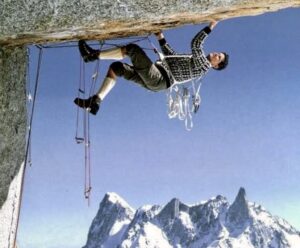This past season, seeking alpine adventure close to home, Simon Richardson and I made the first complete traverse of 4,019m Mount Waddington, the highest mountain completely in British Columbia. We began at the northern end of the massif, and over five days, we crested the false summit, the northwest summit and the main summit, then descended to Rainy Gap, the southern terminus of the mountain. It showed us that even fairly close to large populations — Waddington is less than 300km from Vancouver — it’s possible to cover new terrain and make first ascents.
Such firsts are possible because climbing is now focusing on technical difficulty, leaving some basic adventures overlooked. Our route took us up the lower west ridge for the first 3.5km, originally climbed by Don and Phyllis Munday in 1928. At 3,300m, rather than veer left on the standard Angel Glacier route, we continued straight up the unclimbed cockscomb ridge above. This upper ridge was surprisingly easy going, as we followed a moderate snow ramp below the ridge-crest, allowing rapid access to the hanging Epaulette Glacier.

Blue: Epaulette Ridge route line. Red: Standard Angel Glacier route.
From the flat top of the previously untrodden Epaulette Glacier, we only had to traverse a snow ridge to connect with the upper flat glacier below the summit towers. Known as the Terrace, this glacial bench at 3,900m was separated from us by a knife-edge snow ridge. On either side, 50-degree slopes of metre-deep snow dropped away.
Both Simon and I worried that these slopes could avalanche and stop us short of the Terrace. As a guide, I am very conscious of risk, and proceeded only as far as our three ice screws allowed us. Simon, more bold, unlocked the traverse without finding protection by “down dyno-ing”, as I termed it — a mocking reference to the ever-increasing popularity of staged indoor competition climbing. Actually, Simon jumped into the bergschrund below the slope, a bold move that I would never have contemplated. When I followed him, I found myself snow-covered but safely at the bottom of a crevasse, from which we easily exited.

Simon leads the crux 5.8 mixed pitch at 3,900m.
It took us three days to reach a camp below the summit tower, and we were happy that the main high-pressure system of the summer continued. The true challenge of Waddington, and the reason that it is rarely summited by any route, is that one has to climb 200m of technical ground above 3,800m to reach the summit.
We hesitated at a major feature called The Notch, a quarter of the way up the summit tower, as ice from the summer’s continuous storms was raining down our route. With Simon’s previous experience (eight major first ascents in seven trips to the Coast Range), he decided that the risk was reasonable. A few pitches of beautiful mixed climbing brought us to the upper slopes and the comfortable summit.

Simon Richardson, bottom right, in the summit gully slope of Mount Waddington.
In our time on the mountain, three other teams flew in and left within a few days. Two teams found alarmingly hot conditions, which made climbing dangerous. Sunny Knob, on the south side of the massif and one of the standard camp spots in years past, was reportedly strafed by rockfall several times a day. Simon, who first visited the mountain in 1997, said that the glaciers look entirely different now. Since our route was high on a ridge, it will likely be a safer approach to the Terrace than the old Angel Glacier route, which is now very broken and threatening.






